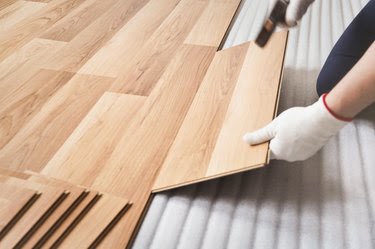Quck answer
Laminate flooring is a popular choice for homeowners due to its durability, affordability, and easy installation. When choosing laminate flooring, consider the following factors:
1. Thickness: Thicker laminates are more resistant to wear and tear.
2. AC Rating: Look for a high AC rating, which indicates durability and suitability for different areas of the home.
3. Design: Choose a design that complements your interior and personal style.
4. Installation method: Consider whether you want a click-lock or glue-down installation, depending on your skill level and preference.
5. Budget: Set a budget and compare prices from different manufacturers to find the best value for your money.
By considering these factors, you can choose the right laminate flooring for your home.
Laminate flooring, often referred to as Pergo, is a cost-effective, long-lasting, and appealing alternative to traditional tile, stone, and hardwood floors. This flooring option is highly popular for its affordability and ease of DIY installation. In fact, most styles can be installed by simply snapping the planks together without the need for glue or fasteners. Many DIY enthusiasts find that the most challenging aspect of working with laminate flooring is choosing the right option.
Types of Laminate Flooring
There are two types of laminate flooring available: engineered wood and plastic laminate. Both types come in 8-millimeter or 12-millimeter planks that can be easily snapped together. Engineered wood consists of layers of real wood that are glued together in a perpendicular manner to enhance stability. The bottom layer is a hardwood veneer backing, the middle layer is a hardwood core, and the top layer is a thin, high-quality hardwood sealed with an acrylic finish.
Despite the criticism that laminate flooring receives for being “fake,” it is worth noting that the National Wood Flooring Association considers engineered laminate to meet its criteria for “real wood flooring.”

Image Credit:
Lubo Ivanko/iStock/GettyImages
Plastic laminate planks are made up of layers of synthetic materials. The bottom layer is melamine, the middle layer is resin-saturated fiberboard, and the top layer features a wood grain, stone, or tile print protected by a clear, hard plastic wear layer.
Choosing the Best Option
There is no definitive answer as to which type of laminate flooring is the best. If you prefer the look of real wood, engineered wood may be the ideal choice for you. However, it is significantly more expensive, usually costing twice as much as plastic laminate flooring. Additionally, engineered wood is less durable and more susceptible to damage from dents, scratches, staining, and water. On the positive side, wood laminate can be sanded and refinished if it gets damaged, allowing it to potentially last longer than plastic laminate in most cases.
Plastic laminate is generally a better option for high-traffic areas or spaces prone to moisture, such as bathrooms or kitchens. Its strong top coat, moisture barrier, and plastic components make it highly resistant to heavy foot traffic and water. When it comes to aesthetics, plastic laminate closely resembles the look of wood, and it is difficult for most people to differentiate between the two. Additionally, if you are looking for laminate flooring that mimics the appearance of tile or stone, plastic laminate is the only suitable option.
Image Credit:
Sergey Nazarov/iStock/GettyImages
Consider Your Lifestyle
Laminate flooring comes in various finishes, ranging from high gloss to distressed. When selecting the right finish for your home, take into account the level of wear and tear your flooring will endure. If you lead a quiet and relaxed life, you can confidently choose any finish that appeals to you. However, if you have children, pets, or frequent visitors, heavy traffic can quickly damage a glossy finish. In such cases, it is advisable to opt for a low-gloss, distressed, or hand-scraped patina, as these finishes will maintain their appearance for a longer period of time.
When choosing the appropriate flooring for your home, it is important to consider the abrasion class (AC) rating. This rating system is used to determine the amount of traffic that a specific laminate flooring product can withstand. The standards for this rating system are as follows:
– AC1: Suitable for moderate residential use, such as guest bedrooms.
– AC2: Suitable for most residential use, including living rooms and dining rooms.
– AC3: Suitable for high-traffic residential areas and moderate commercial use, like hotels.
– AC4: Suitable for most commercial purposes, like offices.
– AC5: Suitable for high-traffic commercial areas, such as home improvement stores and showrooms.
– AC6: Suitable for heavy commercial and industrial use.
It is also important to review your subfloor before choosing a laminate flooring option. The unevenness of your slab or subfloor should be considered when deciding on the width of the planks. Thicker laminate planks are more difficult to install on an uneven floor and may result in gaps between the planks. While underlayment can help fix some subfloor problems, it is recommended to choose a narrower plank if your subfloor is particularly uneven to ensure a secure installation.


